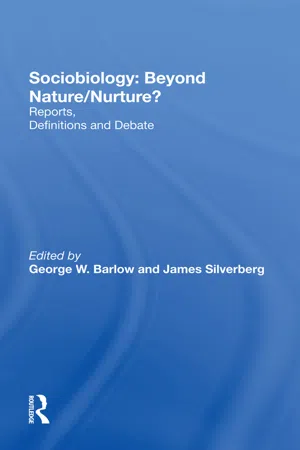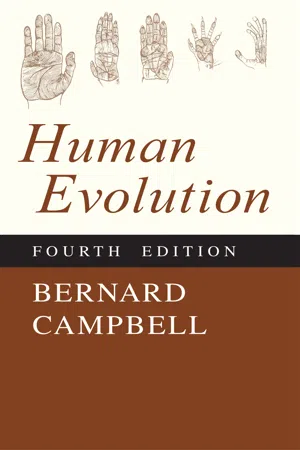Biological Sciences
Organism Behavior and Fitness
Organism behavior refers to the actions and responses of living organisms to their environment. Fitness, in the biological sense, relates to an organism's ability to survive and reproduce in its environment. The behavior of an organism can impact its fitness by influencing its ability to find food, avoid predators, and successfully reproduce.
Written by Perlego with AI-assistance
Related key terms
3 Key excerpts on "Organism Behavior and Fitness"
- eBook - ePub
Sociobiology: Beyond Nature/nurture?
Reports, Definitions And Debate
- George W Barlow, James Silverberg, Frank B Livingstone(Authors)
- 2019(Publication Date)
- Routledge(Publisher)
Part 3The Organism in Its EnvironmentPassage contains an image
5.Ecological Determinism and Sociobiology
Stephen T. EmlenThe field of sociobiology has made major advances and attracted widespread attention during its short decade of existence as a theoretical and predictive science. When one steps back and examines the field, it becomes apparent that research is progressing along two separate, but interrelated, frontiers (Fig. 1 ).The first is concerned primarily with describing the types of behavioral interactions that occur between organisms living within the confines of a particular society. Building upon the evolutionary tenet of natural selection, this frontier attempts to better understand such aspects of social behavior as dominance and submissive interactions, male and female strategies of parental investment and mate selection, parent-offspring interactions and conflict, differential behavior toward members versus “outsiders” of a group, preferential interactions with kin as opposed to nonkin (nepotism), etc. (Fig. 2 ). Some of the recent developments on this frontier have included interpretations of current human behavior in terms of its probable adaptiveness during our recent evolutionary past, and predictions of behavioral interactions based upon the recent expansion of the theory of individual natural selection to encompass kin (Hamilton 1964a, 1964b; Trivers 1974; West-Eberhard 1975).It is this frontier of sociobiology that has attracted wide attention and become the focus of heated debate (Allen et al. 1975; Allen et al. 1976; Wade 1976; Wilson 1976).Evolution is basically a selfish doctrine, preaching that the individual that maximizes its own welfare and reproduction relative to others will gain the selective edge --- by leaving more descendants who, themselves, carry the same behavioral traits. If the basis of a particular human behavior is considered to be largely genetically determined, - eBook - ePub
Human Evolution
An Introduction to Man's Adaptations
- Bernard Campbell(Author)
- 2017(Publication Date)
- Routledge(Publisher)
X. Sociobiology and Human BehaviorSociobiology, the science of the biology of social behavior, is an important and growing branch of biology that is of particular interest to us since we are a very social species. The science, with its roots in the study of social insects, is concerned with the behavior of all social animals from insects to humans. Its origin as a new science can be traced to the concept of inclusive fitness, first discussed by W. D. Hamilton in 1964.The concept implies that the “Darwinian fitness” of an individual not only includes its own reproductive success but that of its relatives, which share the individual’s genes. It is, as it were, the particular packages of genes that are being selected rather than particular individuals. This became clear from the study of social insects such as bees. In this group of insects, because of their unusual genetics with haploid males (i.e., males carry only one-half the normal diploid gene complement, so that the nucleus of the cells does not undergo meiosis in the production of gametes), the daughters inherit a full set of their father’s genes as compared with the usual 50% of their diploid mother’s genes. This means that since each worker bee shares (on average) 75% of its genes with its siblings (50% from having the same father and 25% from having the same mother), it pays it to work for the survival of its siblings as much as (in fact more than) for its own putative offspring, were it to have any, who would carry only 50% of its genes.Similarly, if a bird giving a warning cry can thus protect a number of individuals that share its genes, the gain in survival of its genes may be greater than the loss that would occur if it was killed by a predator. In practice, the selective advantage of an individual assisting a relative in this or any other way will depend on three factors: the risk to its own fitness, the benefit to the relative or relatives, and the degree of related-ness of each relative. We find that on this basis we can account for the selection of what looks like altruistic behavior in close-knit social groups where individuals are closely related. - eBook - ePub
- Christian Sartorius(Author)
- 2003(Publication Date)
- Routledge(Publisher)
Other interactions are much more complex. In the case of fixed action patterns, or instincts, the stimuli as well as the responses may comprise a series of elements which become effective simultaneously or in a given order. In addition, there may even exist a considerable time lag between the stimulation and the response, as shown in the migration or courting and mating behavior of birds. Genetically determined behavior prevails in the majority of organisms. Even in man, it constitutes a small but essential part of behavior. On the other hand, in the course of natural history an increasing share of behavior is the result of learning. In previous parts of this section I already speculated that the capability to learn may contribute to an organism’s fitness. Now I am in the position to explain on a very basic level why learning is necessary and how it is executed. As it was emphasized above, ever-increasing specialization plays a central role in natural evolution. Imagine a unicellular organism that has found a way to use as nutrient a chemical substance encountered in its environment. At first, this organism may acquire this advantageous capability in addition to its previously shown capabilities. Since this strategy is rather costly, it pays only if the supply of this substance is plentiful and there is no challenge from competing organisms—a rather unrealistic assumption. Next, the organism may abandon its capability to use the former nutrients and, thus, become specialized for the new substance. However, this can be a dangerous strategy if the newly used nutrient is not in constant supply. In fact, the concentration of substances in nature often fluctuates strongly. One strategy developed by many bacteria to overcome this problem related to specialization seems to be quite successful: retain the information necessary to utilize all nutrients but express (i.e. synthesize) only those needed for the utilization of substances in good supply
Learn about this page
Index pages curate the most relevant extracts from our library of academic textbooks. They’ve been created using an in-house natural language model (NLM), each adding context and meaning to key research topics.


